

See some items our biggest fan and friend "zipzip" purchased from the estate of Dick York and learn about where Dick and his family lived during the Bewitched years! David says: "In 2009 I was lucky enough to purchase several items from the former estate of Dick York, the original Darrin on Bewitched. Amongst the items were several pieces of Bewitched material which was used by Mr. York during those magical years on the show. Included was his personal copy of the script for episode# 112 CHEAP CHEAP from 1967, which features his name written on the top right hand corner of the cover in pencil. What makes this even more special is the fact that it came with the original Screen Gems envelope which it came in, sent to Dick York personally from the network. I also have his personal call sheet for episode #122 I GET YOUR NANNIE YOU GET YOUR GOAT with the name 'Dick' written on the top right hand corner in red pen. Also included in the lot was his personal shooting schedule for the same episode. Another interesting item is a plastic name ID pin badge from KABC-TV stating 'DICK YORK - BEWITCHED'. How amazing to think this was worn by Dick perhaps during a visit of a studio or something!
As we know Dick was nominated for an Emmy award in 1968 for "Outstanding Continued Performance by an Actor in a Leading Role in a Comedy Series". Sadly he did not win but it is nice to know he was appreciate by other awards and as you will see, he recieved a wooden plaque awarded to him for his role on Bewitched in 1966 by The Los Angeles Metropolitan District California Federation of Women's Clubs. It is a lovely thought to think that he may have had this hanging in his home and taken great pride for this honour.
I also have 3 paintings. They are unsigned and undated though did come from his estate. Dick did enjoy painting in his spare time. Although the frames are a little tired looking I have kept them in their original frames as I could not bear to remove them. The have been professionally framed with brown paper covering the back of the frame. From what I can see, one painting seems to resemble a male and female figure (blue one), a mermaid or something and a trible scene.
I am extremely honoured and privileged to own such items. I shall cherish them for all time and hope you enjoy having a personal insight to Dick York's Bewitched years".
David Bennett
Avid Bewitched collector, fan and enthusiast.Update: I recently received these pictures and accompanying e-mail from David.
"Hi Wendy, here are the photos of Dick York holding the paintings that I have in 1965. I was so overcome with joy when I found these pictures of Dick York posing with the 3 paintings I now own! These are from 1965 and it is so lovely to see him with the paintings! What a find! Hope you like them as much as I do". David
Also recently from David: "I have attached the three pages of sketches that was in a sketchbook that belonged to Dick York. The sketches seem to be of his children. The first one has written above the head 'Kim' and there is the name 'Matt' too. The second one seems to be a larger sketch of Kim. The third is a sketch of a boy, perhaps Matt? Mr. York was a very talented artist and I am so proud to be able to share them with you here on bewitched.net".
Webmaster note and additions:
Seeing the envelope addressed to Dick triggered my thinking about his house, so I thought all of you might like to see where the York's lived in during the Bewitched years. It looked as if it was chosen by the Yorks to be strategically located between both sites of his job - Sunset Gower studios for interior set filming and the Columbia Burbank ranch (now Warner Bros ranch). This meant for an easy commute - a mile to the studio and about 5 miles to the ranch. Nice planning! As you can see from the above envelope, they lived in a quaint hillside neighborhood on Scenic Ave. The house was a 4 bedroom 2 bath 2296 sq. ft on .17 acres with a pool, built in 1928. The current value of the home is $921,500 and it was last sold May 7, 1973 for $31,000. That means the Yorks stayed there about 4 years after he left the show - and that the family that purchased it still owns it today.
See some pictures of Dick's commute route to the ranch and to the studio - he was only a block or so away from Gower St. The green "A" balloon marks Dick's home.
Looking down the street, house on right (below) Looking up the street, house on upper left (below)
See 4 video clips of interviews with Dick York during his final days below. He describes his relationship with Elizabeth and what led to him leaving Bewitched. He also discusses the hard times which fell on his family afterwards, and much more.
Dick York Interview 1
(Part 1 of 2)
(Part 2 of 2)
Dick York Interview 2
(Part 1 of 2)
(Part 2 of 2)
FilmFax, April 1992: Dick York - A Farewell Interview His credo was: "You've got to keep trying..."
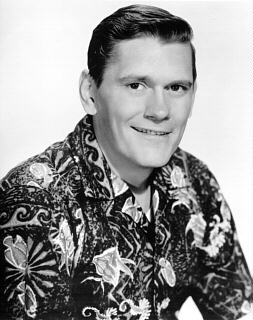
DICK YORK
Instantly recognizable as "Darrin" from the classic sitcom Bewitched,
Interview by JOHN DOUGLAS
this actor endured more than his share of bad luckThis article is the result of several interviews held with Dick York at his home in Rockford, Michigan, at various times during 1991. Regrettably, York died in February of this year [1992]. The quotes in the story came from those interviews and from Seesaw Girl, York's autobiography which, at the time, was unpublished and which he graciously allowed me to use.
-John Douglas
When an ailing Dick York was replaced on ABC's supernatural sitcom, Bewitched, the show dropped 13 places in the ratings. After five seasons, York's "Darrin Stephens" had become a member of the family and the audience was confused-particularly since replacement Dick Sargent was never explained. Today, one cable channel even refers to Sargent as "the other guy." York's shoes were hard to fill.
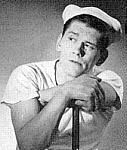
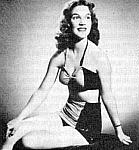
Unfortunately, York's life has not been similarly successful. The veteran of stage, screen, radio and television now lives modestly in Rockford, Michigan, with Joey (actress Joan Alt, at right in a rare old publicity still), his wife of 39 years and the mother of their five children. But York, still gregarious and warmhearted, is a victim of emphysema and a debilitating injury which occured while he was on location for Robert Rossen's film They Came to Cordura. He now spends most of his days in an over-stuffed chair hooked up to an oxygen tank, but his physical handicaps do not prevent him from being very active on the telephone raising money, and encouraging donations of food and clothing for the homeless-a project that is very important to him. In fact, York lives so much in the present, it's actually difficult to get him to talk about the old days.
York was born in Ft. Wayne, Indiana, on September 4, 1928, but during his formative years the family moved to Chicago where his parents enrolled him at Jack and Jill Players, a children's dramatic school. York was nine years old. The training paid off and the talented tyke landed roles in locally produced radio shows. During the early days of the war, York donated his talents to such morale boosting shows as On Guard with the Coast Guard, and That Men May Live, but in 1943 he finally got his first paying job on a show called That Brewster Boy.
"It was an imitation of The Aldrich Family, explained York. "Eddie Firestone, who originally played the title role, had joined the Marines. I was 15 when I auditioned and got the part."
Considering the tumultuous times, it wasn't long before the teen was involved in political matters far beyond his experience.
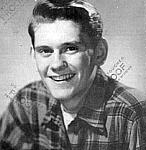

"Pauline Hopkins and Owen Vincent were the writer and director of That Brewster Boy. They were sending bundles to the Communists to help fight the Nazis so naturally they were branded as Communists. The advertising agency [ad agencies owned many of the radio shows of that era] came around, hired everyone from under them and they were going to change the name of the show and get rid of Pauline and Owen. Well, I was fresh out of the slum. It was the first time I ever had any money, but I went to Pauline and Owen and told them straight out that I didn't know what it was all about, but that I was with them. I wouldn't sign with the agency. Of course, I was taken off the show." [The new version of That Brewster Boy was called Those Websters.]For the most part, however, York has some very fond memories of his radio days. For him, it was a time when actors and other creative people often pulled together and helped each other. York also believes that honesty is still the best policy --- even in show business. For example, York was at one time being considered for a leading role on the highly rated radio show, The Aldrich Family.
"They were auditioning to replace Ezra Stone [who played Henry Aldrich]," recalled York, "and I was one of the people they were considering. Then Jim Jewell, who wrote, produced and directed Jack Armstrong-The All American Boy, called and asked me if I would come over and play Billy Fairfield. I told Mr. Jewell that, to tell the truth, I was being considered for Henry Aldrich. He asked if I would play Billy Fairfield until I heard from the Aldrich people and I said yes."
"As it turned out, they chose another boy for Henry Aldrich, but I was on Jack Armstrong and I wouldn't have accepted that job from Jim without telling him the truth."York stayed with Jack Armstrong during the period that it went from a 15 minute show to a half hour program with the new name Armstrong of the S. B. I. in 1950. At the same time he also appeared on other Chicago originated radio shows such as The Whistler and The First Nighter and had his own weekly variety show beginning in 1946 called Teen Town (later called Juvenile Junction).
"Teen Town was written by, for and about teenagers," stated York. "Ralph Marterie played trumpet and led the band. Mary Hartline [later of television's Super Circus fame] was a beautiful young girl with great legs and a nice body,who waved the baton around. She was really a cheerleader kind of girl, and Harold Stokes, her husband, created the show so she could lead the orchestra. It was love. Her talent was being beautiful and kind, and that was enough."
But doing multiple radio shows, often without lengthy rehearsals, made life constantly chaotic.
"You'd go in, read the script once for timing and then you would sit around and play games," said York shaking his head. "The sound effects people would come in and we would do a dress rehearsal so they could get the effects and the music cues in place. Then you would wait until you went on the air. You only got to read the script through twice, actually."
Another factor that added to the confusion was the existence of the various time zones in which the radio shows would be heard. In those days of live broadcasts, the shows often had to be done more than once. For example, Jack Armstrong, which originated in Chicago, had to be done twice, once for the East and an hour later for the West.
York, circa 1953
Sometimes it got even more complicated as York revealed.
"With a show like The F.B.I. in Peace and War that came out of New York, there was a three hour differential in performances because the sponsor insisted it be done live for California. You would go on at 8 pm in New York but you would also have to go on at 8 pm. in California. That meant coming back in to do the show at 11 pm. Sometimes actors would forget the repeat and you would end up doing a hell of a lot of parts. I did a show once where Ralph Bell was talking to himself!""But, radio allowed people to act with their hearts and minds," said York With emphasis. "There were certain people who I thought were really radio actors--Orson Welles, Everett Sloane, Agnes Moorehead, Elliott Lewis, Joe Julian, Hugh Studebaker and Ken Griffin. Everytime I listened to Lux Radio Theatre, however, I wanted to vomit. [Lux Radio Theatre presented radio versions of popular movies in which movie stars played the important roles, sometimes actually recreating their roles from the movie.] Some of the film people didn't know what the hell their line said! It drove me nuts to hear all those misreadings."
In spite of his problems with movie stars acting on radio, York did manage to land some movie roles of his own during those early days in Chicago. The films he starred in were not big Hollywood productions but commercial and educational films for both Wilding Films and Coronet Films. Richard Prelinger has preserved many of these lilms in which York appeared as a teenager in collections ca1led Ephemeral Films, available on videotape cassettes through Voyager Press. York turns up, for instance, as a teenage drunk driver in The Last Date where his actions put other teenagers, including his girlfriend, in jeopardy. He also appears in Shy Guy, which offers some dating tips to teenagers.
Still, radio was York's major source of income, and it was radio that led him to New York City in 1950. He moved into the YMCA and floundered around the city for six months. But eventually, the relocation offered opportunities to show off his skills as an actor on television and the stage.
One of the New York radio shows was an episode of Michael Shayne, a series about the adventures of a private eye. In the episode, York played a young drug addict. His performance so impressed Deke Hayworth, the writer of the show, that he sent York to see agent Deborah Cleman, who in turn sent York to see director Elia Kazan who was casting Tea and Sympathy, a drama about homosexuality in a boys school.
"I went in, read and, at first, I was cast as the villain, the one who picks on the homosexual," York recalled. "But I told Karl Malden, who was conducting the auditions for Kazan, that I felt I was better suited for the boy's friend."
York left the audition but stopped in the men's room. When he came back out into the hall Malden was looking for him and wanted him to come back to read for the other part.
"I went back in and read it once and he says, 'You're it.' I played the friend."
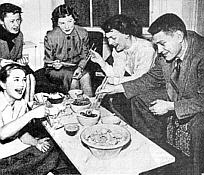
The cast of the This Is Nora Drake
radio show take time out for some takeout.
During the run of Tea and Sympathy (which also starred Deborah Kerr, John Kerr and Leif Erickson), York continued to be heard on the radio soap operas This is Nora Drake, Young Doctor Malone, and Rosemary. York managed to talk each of the soap opera producers into writing him out of the shows during the out-of-town try-outs for the play.
After Tea and Sympathy opened in September, 1953, to successful reviews, all York had to worry about were the Wednesday matinees of the play. Before doing the morning soap operas on matinee days, York would get into costume and make-up for the theater. "I left the studio while they were reading the last commercial," laughed York, "and ran to the Barrymore Theatre across town. My understudy Yale Wexler [brother of cinematographer Haskell Wexler], would stand at the rear door and if I didn't make it he was to go on for the matinee. But I never missed a Wednesday matinee and Wexler hated me for it."
Television was quickly replacing radio as the population's favorite form of at-home entertainment and by 1955 York had added Million Dollar Rookie with Buster Crabbe, ("For an Olympic swimmer he was a wonderful actor," says York kindly.) and Drop on the Devil with Ford Rainey for Kraft Theatre to his list of credits, plus Incident in July with Maureen Stapleton on Philco Playhouse. That same year York also appeared in Gore Vidal's science fiction comedy Visit to a Small Planet on Goodyear Theatre.
After the television production of Planet, Vidal did some revisions and made it into a successful Broadway play. There was also a film version starring Jerry Lewis (replacing Cyril Ritchard from both the TV and stage version).
York did not appear in either the movie or the Broadway play. "Gore Vidal was pissed," York laughed. "He wanted me to do Planet on the stage, but I got aboard Night of the Auk instead and he said, 'Ha, ha, you got on the wrong spaceship, you prick.'"
Night of the Auk, was another science fiction Broadway play-something of a rarity. The drama was set on a space ship and it was written by the legendary writer of radio drama-Arch Oboler, creator of the popular horror anthology Lights Out and director of the first successful 3-D movie, Bwana Devil (1952).
If nothing else, the cast for Night of the Auk was exceptional. Besides York, the five-actor play boasted Claude Rains, Christopher Plummer, Wendell Corey and Martin Brooks. It was directed by veteran live television director Sidney Lumet, who immediately after working on the play, began an illustrious movie career as a film director beginning with 12 Angry Men and continuing with Fail Safe, The Pawnbroker, Dog Day Afternoon and Serpico. With all that combined talent, it's difficult to understand why the play wasn't a hit.
From the description of the production in The New York Times review on December 4,1956, the play seems similar to Oboler's Rocket From Manhattan which he wrote for Lights Out. In the play, which was written in verse, some astronauts, who have just been the first men to land on the Moon, are returning to Earth and dealing with all sorts of angst. Times critic Brooks Atkinson wrote: "The boys who are manning the space ship are not doing too well. They left one of their number to die on the moon, and they all seem to feel a little guilty about that oversight. On the journey back they drop a couple more through the hatch to die in the cold spaces of the planetary night, and another commits suicide magnanimously. Two are left with some remote chance of living while the rocketship shrieks down toward Earth."
But that's not all. As the astronauts are about to land the ship, nuclear war breaks out on Earth. Atkinson thought it was all too much for one play, but he was kind to the performers who he believed did pretty well with what they had to work with. Unfortunately, the play, which opened December 3, 1956, at the Playhouse Theatre on 48th St., closed the next day.
"We did that play as well as anyone could do it," reflected York, "but we weren't going to fool anyone into thinking it was what it wasn't. He [Oboler] wanted to fire me because I insisted on telling the truth. For that man to call me up and tell me he didn't like my performance when he didn't realize what the hell I was doing -you made it hell for me, Arch, that's what you did."
Night of the Auk was York's last appearance on the Great White Way. He did, however, have one other experience on Broadway prior to Auk and after Tea and Sympathy. York was approached to play the cowboy in William Inge's Bus Stop in 1955. Due to a contractual obligation with Columbia Pictures he was unable to participate in the play until later, when, for a short time, he took over the role from Albert Salmi who had gone on to other projects. It was the infamous Harry Cohn, eccentric head man at Columbia Pictures, who stood in the way of York opening in Bus Stop.
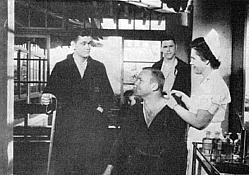
Dick York co-starred with Aldo Ray (sitting) in
the army drama Three Stripes In The Sun (1955)
"I had done my first picture [My Sister Eileen] and I didn't have anything to do for awhile," stated York. I was asked to come back to New York and do Bus Stop in the role of the cowboy opposite Kim Stanley. They called Harry Cohn and he said, 'You can have my actor if you give me the movie rights to the play.' They said, 'Come on, Harry, you can use him anytime! Harry said, 'Oh, no. I need him now! So he quickly found something for me to do-he sent Aldo Ray and me to Japan to do Three Stripes in the Sun."
Three Stripes in the Sun, which was directed by Richard Murphy, was based on a true story. The gravelly voiced Aldo Ray plays a soldier who hates the Japanese and who is stationed in post-war Japan. The soldier's heart is eventually softened due to his love for a Japanese woman and an orphanage of children.
"It's a damn nice little picture," said York who played Ray's Army buddy Cpl. Neeby Muhlendorf.
Ironically, York had received his first screen role in the musical My Sister Eileen because Aldo Ray had turned it down. Ray thought that the part was too small and the result was, Dick York became a Bob Fosse dancer.
"I had to sing and dance in that movie," chuckled York. "I never danced a step in my life so naturally my first motion picture was a musical, and Bob Fosse was the choreographer. Another claim to fame. 'Well, yes. I'm a dancer. I danced for Fosse.' I didn't exactly dance for Fosse, I just did the best that I could to do what he taught us to do."
During the late '50s and early '60s, York commuted back and forth between coasts. In New York he continued to work on live television productions such as Playhouse 90, Alcoa Presents, Studio One, The United States Steel Hour and Climax.
York remembers that in one live drama on Playhouse 90 called Last Clear Chance, he co-starred with Paul Muni, who was reaching the end of his long and distinguished career. Muni was having trouble remembering his lines so they came up with the idea of giving him a hearing aid which was hooked up to a radio receiver in his pocket. During the play, Muni's wife fed him the lines and York said that Muni was such a great actor that no one could tell what was going on.
In California, York did television shows that were shot on film. From 1957 to 1963 York appeared seven times on Alfred Hitchcock Presents ("I never met nor saw Hitchcock," said York) and twice on The Twilight Zone (The Purple Testament and A Penny for your Thoughts). York was also the only actor to receive two separate million dollar checks as characters on The Millionaire (The Ken Leighton Story and Millionaire Sandy Newell).
As live television drama, most of which originated in New York City, faded from the scene, York moved his family to Los Angeles and appeared in such television series as Stagecoach West, Naked City, The Untouchables, Rawhide, Frontier Circus, Adventures in Paradise, Wagon Train, Dr. Kildare and in The lncredible Doctor Markesan episode of Thriller.
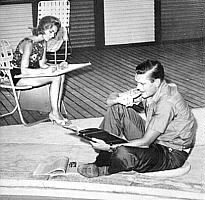
"I can tell you how they got Karloff's face to deteriorate," York explained. "The make-up man took Bromo-Seltzer, ground it up real fine and put it on his face with the facial make-up. They they sprayed him with water and it went pop, pop, pop, and his face just kind of deteriorated. It was a great idea."
York also had a role in A Musket for Jessica, a frontier-life story that Ronald Reagan introduced on The General Electric Theater. York co-starred with Piper Laurie. "Piper insisted she had to be out of breath when we played this one scene," said York shaking his head. "so she ran around the block. Thank God she wasn't doing a crucifixtion scene; we would have had to nail her to the wall."
During this highly productive television period York continued to make movies too. Operation Madball, which was released in 1957 and directed by Richard Quine, is notable for being Ernie Kovacs' first film. The story is about a soldiers' party and the mean commanding officer (Kovacs) who wants to squelch the G.I. get-together. York played one of his toadies.
"I was supposed to be helping Ernie, but I wasn't," said York. 'I was really working with Jack Lemmon and Mickey Rooney who were trying to get the mad ball going. Ernie was using this Vicks inhaler in his scenes and that gave me an idea. I told Dick Quine that I bet I could get to Kovacs and to watch for something at the end of the scene.
"So we did the scene and Ernie's upstaging me with this inhaler. 'You got that, Bowun?' And I say, 'Yeah, I think I can handle that, sir.' At that very moment I whipped out an inhaler and took a sniff. Ernie looked at it and his eyes got big and round. Dick Quine yells, 'Cut!' And Kovacs says, 'You son of a bitch. I set up this inhaler gag through the whole scene and you knock it off.'"
York (left) co-starred with Van Johnson
in The Last Blitzkrieg (1958)
It was obvious, as York told story, that he was quite pleased to have topped Kovacs, one of the most creative funny men that television ever produced.
Two other York films were released in 1958. The Last Blitzkrieg, directed by Arthur Dreifuss, and Delmer Daves' Cowboy. Westerns often presented a unique challenge. "Westerns ain't a lot of fun when you've got 3000 head of Mexican cattle that spook everytime a mouse farts. We chased those suckers for miles and miles. We finally got to the stampede scene and these damn cattle were so tired that they had to set up dynamite charges to get them to run."
York (right) appeared with Gary Cooper in the classic
Spanish-American war drama They Came To Cordura (1959).
The next movie York made was destined to change his life. It was during the production of They Came to Cordura (1959) that York injured his back, an injury that was to plague him for the rest of his life.
In They Came to Cordura York found himself in the august company of Gary Cooper, Rita Hayworth ("My God she was beautiful!"), Van Heflin, Richard Conte, Tab Hunter and Michael Callan, who were all portraying characters in a story of courage during the Spanish American War. The film was shot in Utah and outside of Las Vegas, but all was not well on location. Director Robert Rossen (All the King's Men and The Hustler) was having trouble with alcohol.
"Anyone who would let Gary Cooper and the entire cast go charging on horseback without first finding out what kind of footing the horses had is nuts and cannot possibly direct a motion picture," proclaimed York, shaking his head. "Cooper's horse hit slate and went sliding. Then the horse behind him came up and we went bam, bam, bam. Everyone in that picture could have been kicked to death by those horses. Rossen was a good director, but he was an alcoholic."
And then it happened.
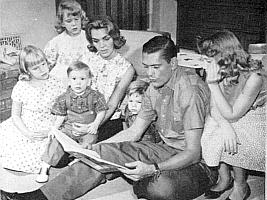 "It was the last shot of the day and tomorrow we would wrap Cordura. In the scene, Cooper and I were propelling a hand car carrying several wounded men down an abandoned railroad track. As we passed the camera I was on the bottom stroke of this sort of teeter-totter mechanism that made the handcar run. I was just lifting the handle up as the director yelled 'Cut!' and one of the wounded cast members reached up and grabbed the handle. Now, instead of lifting the expected weight, I was suddenly, jarringly, lifting his entire weight off the flatbed-180 pounds or so. The muscles along the right side of my back tore. They just snapped and let loose.
"It was the last shot of the day and tomorrow we would wrap Cordura. In the scene, Cooper and I were propelling a hand car carrying several wounded men down an abandoned railroad track. As we passed the camera I was on the bottom stroke of this sort of teeter-totter mechanism that made the handcar run. I was just lifting the handle up as the director yelled 'Cut!' and one of the wounded cast members reached up and grabbed the handle. Now, instead of lifting the expected weight, I was suddenly, jarringly, lifting his entire weight off the flatbed-180 pounds or so. The muscles along the right side of my back tore. They just snapped and let loose."And that was the start of it all--the pain, the painkillers, the addiction, the lost career. I didn't attend to the problem then. I continued to work through it. At that age, you believe you are bullet-proof and that nothing's ever going to hurt you."
"My spine healed incorrectly," continued York. There were long periods when I'd be perfectly all right, and then there were many other times when I wasn't, when my back would give out and throw me down to the floor amid waves of nauseating pain."
From 1959 until he left Bewitched, York worked with ever increasing pain, particularly during the making of Inherit the Wind (1960), directed by Stanley Kramer and starring Spencer Tracy and Gene Kelly. York played Bert Cates, a character based on John T. Scopes, the Tennessee teacher who was accused of teaching evolution.
Skip to the details of Dick's Bewitched career
"When I did Inherit the Wind," recalled York, "I learned about teaching school. I also found out what a fundamentalist was. I had to convince myself that Scopes was taking a stand because he felt it was right and not because he was some smart ass. When I did that, Kramer said, 'Why don't you write the first scene?' So, I wrote that first scene when you see me talking to the kids."
York teaches Darwinian
theory to his students with
the aid of an evolution chart
in Inherit The Wind.
Spencer Tracy confronts
York with the crucial question
"Do you want to go on with this
case?" as Gene Kelly looks on.
York as Bert Cates, the
John T. Scopes counterpart,
in Stanley Kramer's
Inherit The Wind (1960).
Stanley Kramer gives some final
instructions to York before a take
Working with Spencer Tracy is obviously one of York's fondest memories. "It was such a joy. We were doing a scene in the courtroom and Tracy turned and looked at me in the middle of the scene and his eyes were ablaze and he spat out the question that he had to know: 'Do you want to go on with this case?' And in that electric moment my reaction was as good as anything I've ever done, because Spencer Tracy made it that way. When the scene was over, we both smiled. Neither one of us said anything."
From left, Fredric March, Gene Kelly,
Dick York and Spencer Tracy share a laugh between
takes on Stanley Kramer's docu-drama Inherit The Wind.
Inherit the Wind turned out to be York's last feature film, but he continued to perform as a guest on television series. Wind, however, was not the last time York was destined to work with Gene Kelly.
On October 3, 1962, the first episode of Going My Way appeared on ABC. The series was based on the 1944 Leo McCarey film which starred Bing Crosby and Barry Fitzgerald. Gene Kelly took the role of Father O'Malley on the series and Leo G. Carroll portrayed Father Fitzgibbon, Fitzgerald's slot, in the TV series. York played Tom Colwell, a character created especially for the series, who was the boyhood friend of Father OMalley's and ran the community center.
York is still grateful to Kelly, whom he feels had great understanding about the pain which York had to endure because of his back problem.
"My back flared up about 25 shows into the Going My Way season," stated York. "Terrible spell, and all the shots and therapy didn't seem to work. Operations were recommended, all the way from fusion to removal of several vertebrae. You know how that kind of scare thing goes. Anyway, when I reported back to work after seeing the doctor, all the sets had ramps built on them, places for me to ease myself into position. Gene Kelly was not only the star of the series, he was also the producer. Never a word was spoken."
Going My Way, an hour show, lasted only one season, but York attributes its failure to being up against the highly popular The Beverly Hillbillies for its first half hour.
"In the summer when the reruns began, the ratings went right through the roof, but they had already released everybody."
In September of 1964, York's first episode of Bewitched went on the air. One his fondest memories is the day he went in to read for the series and met Elizabeth Montgomery for the first time.
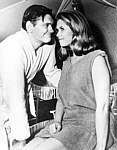
"I walked into the office to read for Bewitched and Liz was sitting there. She unfolded those gorgeous legs and looked at me. I saw her in person for the first time. She had full lips and dark soft hair. She was sex all over. Still are, Lizzie, you still are ...."York won the role of Darrin Stephens and all was going well. The show, which was about a suburban witch (Montgomery) married to a conservative advertising executive (York), was a hit. Everyone especially liked how Montgomery twitched her nose and made the impossible happen. But they also remember York fondly as the constantly perplexed husband. But York's success was constantly plagued by his old injury. It was the beginning of the end of his career.
In his autobiography, Seesaw Girl, Dick York tells the story of the rest of his life. It is reprinted here with his permission:
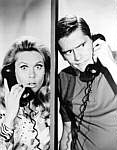
"I was seeing everything through pain. I would roll out of bed and do my exercises. I had to do that to work out the remainder of the pain pills. I would drink coffee and what have you and go to the set and plunge myself so far into my work. I went to a Gestalt therapist and said that I want to be able to at least tell my muscles that aren't involved that they don't have to go into spasms too. He said, 'Good thinking,' and we worked on that. I had to let hurt what did hurt. I realized that if I walked straight it was going to hurt in a certain area, but if I compensated for it, it was going to make other things go out. So, when it became unbearable, I could get novocaine and cortisone shot into my back."I took pain pills to get to sleep because I didn't want to go to work the next day exhausted."
And then, things got worse.
"I lay in my dressing room after being in make-up waiting to go on. They knew I was feeling pretty rotten and they tried to give me time to rest. But I couldn't sleep. I couldn't do anything. Now I hear Billy Asher [producer/director of the show and Montgomery's husband] calling 'Action!' and I can hear Maurice Evans [Samantha's warlock father]."I got through the scene at the table with Maurice. Fortunately, I was supposed to look confused and disoriented because, God, I felt that way.
"I went to the doctor that afternoon. Couldn't get in touch with Billy [Dr. Bill Branch] so they sent me to another doctor and I told him all the symptoms. He gave me a shot of B-12 vitamin which he said would get me through the day.
"I kept having chills. This was in the middle of the summer and I was wearing a sheepskin jacket and I was chilling. I was shaking all over. I went back to the dressing room. That's right. I went back to the dressing room. I'd been allowed to see the doctor on my lunch hour and I skipped lunch and went to see him. Strange how those things never occur to you to say, Hey, wait a minute, maybe I should lie down and take a rest or maybe I should have something to eat or maybe say to the director that I'm going to work until noon and then I'm going to collapse. I'm going home.
"But none of those things happened. Instead, you find yourself on a scaffold with Maurice Evans being lit for a special effects scene. You're supposed to be about 15 feet up in the air and you're supposed to be floating and it's kinda critical to light.
"They were setting an inky-that's a little tiny spot that was supposed to be filling in my eyes. Someone kept passing his hand back and forth in front of the light to see where the light was falling, all very difficult, but somehow that flickering made me feel weird and I'm sitting on this platform up in the air and Maurice is sitting there too and I'm trying to go over my lines. They're kind of gibberish lines; they really don't mean a damn thing. But I know that they're a stickler for these lines being exactly the way they're supposed to be. If this line is bibbety wham bang whoppo, that's what you better say. Anyway, I'm running those lines back and forth and they're making less and less sense to me and this light is flickering off and on and I turn to Gibby, a friend of mine on the set who was just down below, and I said, 'Gibby, I think I have to get down,' and I put my hand on his shoulder and he said, 'Sure, Dick.' He really looked concerned and he started to help me down and that's the last thing I remember until I woke up on the floor, somebody had me in their arms. I didn't quite know who, people looked so unfamiliar. I saw David White's (Larry Tate on the show) face and he had such a look of abject agony and horror and fright. My dearest friend on the set. We'd been through things together, we'd known each other a long time, we fought many a battle together....
"That's about all I remember about that incident. I seemed to be in and out of consciousness. I remember being strapped on a stretcher and an ambulance coming to the door of the set, racing me over to the hospital. I remember waking up in the hospital...
"It wasn't until Joey got there and the doctor was tending to me, was talking to us, that I got the first real inkling of what was happening. I'd been talking to Joey and the doctor and I was saying I'd been exhausted and I had been sick and I probably just needed rest. The doctor and Joey turned to leave and I saw that clearly. I saw them turn to leave and the next moment they were back at my bed and the doctor had a syringe in my arm. I'd managed to bite a very large hole in the side of my tongue before they could pry my teeth apart. By all evidence, and there's no denying it, that thing I had on the set was a fit.
"'You hear that? Guy had a fit on the set! "'What the hell do you suppose that really means?'
"'Well, too many drugs.'
"'Too many drugs....'
"I know it's not you saying that, people in the audience, but a lot of people were, and I guess they've got a right to those questions and these answers.
"After all, didn't I blow a magnificent career?"
Then a decision was made by York and by producer/director Bill Asher.
Again, from York's writings.
"Bill Asher comes to the hospital and he says, 'What do you want to do, Dick? Do you want to quit?' I said, 'If it's all right with you, Billy.' He looked at me, and I guess he and Joey had talked and I guess Bill knew when people had enough and he said, 'OK, kid, I'll tell 'em.'"And Bill Asher and I hugged for the first time."
York remained sick and on his back for over a year.
"After 18 months I was healed up but I was afraid. So we bought an apartment building and were going to live off the rent money. We rented to people who were on welfare and a lot of times they couldn't pay the rent. We wouldn't throw them out so we lost the building."And then Joey and I cleaned apartments and the boys helped out by selling newspapers and collecting tin cans. And they got jobs as waiters and busboys and I had unemployment.
"All my teeth rotted and broke off. We ate a hell of a lot of potatoes and noodles. I got to 306 pounds. I went out for every job they sent me on. I auditioned to direct a school play for $600 but I wasn't good enough."
Then one day York decided it was time to turn things around.
"I went on a diet. I borrowed money to get my teeth fixed. It took a year and I brought myself down to l60 pounds. Then I got an agent and within two weeks I got a job and the following week I got another job. That's unheard of."I did Fantasy Island and the next job was on Simon and Simon. Then I tried out for High School, USA, a pilot film that producer Leonard Hill had me read for the villain of the piece. I wasn't right for it but Henry Gibson was. So they called up and offered me the part of the guy who supplies all the money to the school."
[The pilot, which aired May 26, 1984, didn't sell even though it had a most unusual cast that included, besides York and Gibson, Rick Nelson, Harriet Nelson, Melody Anderson, Jerry Mathers, Burt Ward, Barbara Billingsly and Crispin Glover. Interestingly enough this was the second pilot filmed. The first, which aired on October 16, 1983, starred Dwayne Hickman, Angela Cartwright, Tony Dow, David Nelson, Michael J. Fox, Anthony Edwards, Crispin Glover, Bob Denver and Elinor Donahue.]
Finally, York appeared on a comedy project produced by Johnny Carson.
"I had to join AFTRA which cost me $900. Carson gave me 1,000 for a half day of work. By the time I paid the union and my agent, the check came to $3.50."Then everything stopped.
"I didn't get any more calls and that went on for a year. I started teaching acting in Hollywood. That kept me in money."York was to discover that his agent had failed to register him properly with the Screen Actor's Guild. Therefore, they had no agent of record for York. York discovered this when he happened to speak to someone at the Screen Actor's Guild on another matter. He mentioned his dry spell and was told that he had received plenty of calls, but since they had no agent listed for him, and were not allowed to give out home telephone numbers, they were unable to help prospective employers.
That was the end of show business for Dick York and the beginning of a new career. York has decided to dedicate his life to helping the homeless. From his living room York makes telephone calls to old and new friends in his attempt to provide some form of help to the needy. York's big dream is to convert unused military bases into homes for those who now live without dwellings.
And York still suffers constantly from chronic back pain, as well as emphysema. But, the man's spirit cannot be denied.
"I've been blessed. I have no complaints. I've been surrounded by people in radio, on stage and in motion pictures and television who love me. The things that have gone wrong have been simply physical things."On the afternoon of February 20, 1992, York lost his courageous fight against those "physical things."
In the fell clutch of circumstance
I have not winced nor cried aloud
Under the bludgeonings of chance
My head is bloody, but unbowed
--from Invictus by William Ernest Henley
DICK YORK
1928-1992
Read a 1953 article about Dick York here
Back to The Bewitched And Elizabeth Montgomery Page